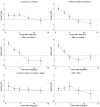Subtyping of breast cancer by immunohistochemistry to investigate a relationship between subtype and short and long term survival: a collaborative analysis of data for 10,159 cases from 12 studies
- PMID: 20520800
- PMCID: PMC2876119
- DOI: 10.1371/journal.pmed.1000279
Subtyping of breast cancer by immunohistochemistry to investigate a relationship between subtype and short and long term survival: a collaborative analysis of data for 10,159 cases from 12 studies
Abstract
Background: Immunohistochemical markers are often used to classify breast cancer into subtypes that are biologically distinct and behave differently. The aim of this study was to estimate mortality for patients with the major subtypes of breast cancer as classified using five immunohistochemical markers, to investigate patterns of mortality over time, and to test for heterogeneity by subtype.
Methods and findings: We pooled data from more than 10,000 cases of invasive breast cancer from 12 studies that had collected information on hormone receptor status, human epidermal growth factor receptor-2 (HER2) status, and at least one basal marker (cytokeratin [CK]5/6 or epidermal growth factor receptor [EGFR]) together with survival time data. Tumours were classified as luminal and nonluminal tumours according to hormone receptor expression. These two groups were further subdivided according to expression of HER2, and finally, the luminal and nonluminal HER2-negative tumours were categorised according to expression of basal markers. Changes in mortality rates over time differed by subtype. In women with luminal HER2-negative subtypes, mortality rates were constant over time, whereas mortality rates associated with the luminal HER2-positive and nonluminal subtypes tended to peak within 5 y of diagnosis and then decline over time. In the first 5 y after diagnosis the nonluminal tumours were associated with a poorer prognosis, but over longer follow-up times the prognosis was poorer in the luminal subtypes, with the worst prognosis at 15 y being in the luminal HER2-positive tumours. Basal marker expression distinguished the HER2-negative luminal and nonluminal tumours into different subtypes. These patterns were independent of any systemic adjuvant therapy.
Conclusions: The six subtypes of breast cancer defined by expression of five markers show distinct behaviours with important differences in short term and long term prognosis. Application of these markers in the clinical setting could have the potential to improve the targeting of adjuvant chemotherapy to those most likely to benefit. The different patterns of mortality over time also suggest important biological differences between the subtypes that may result in differences in response to specific therapies, and that stratification of breast cancers by clinically relevant subtypes in clinical trials is urgently required.
Conflict of interest statement
Research in the Genetic Pathology Evaluation Centre is supported in part by an unrestricted educational grant from sanofi-aventis Canada.
Figures



Comment in
-
Prognostic significance of subtype classification for short- and long-term survival in breast cancer: survival time holds the key.PLoS Med. 2010 May 25;7(5):e1000281. doi: 10.1371/journal.pmed.1000281. PLoS Med. 2010. PMID: 20520798 Free PMC article.
References
-
- Perou CM, Sorlie T, Eisen MB, van de Rijn M, Jeffrey SS, et al. Molecular portraits of human breast tumours. Nature. 2000;406:747–752. - PubMed
-
- Callagy G, Cattaneo E, Daigo Y, Happerfield L, Bobrow LG, et al. Molecular classification of breast carcinomas using tissue microarrays. Diagn Mol Pathol. 2003;12:27–34. - PubMed
-
- Oh DS, Troester MA, Usary J, Hu Z, He X, et al. Estrogen-regulated genes predict survival in hormone receptor-positive breast cancers. J Clin Oncol. 2006;24:1656–1664. - PubMed
Publication types
MeSH terms
Substances
Grants and funding
LinkOut - more resources
Full Text Sources
Other Literature Sources
Medical
Research Materials
Miscellaneous

